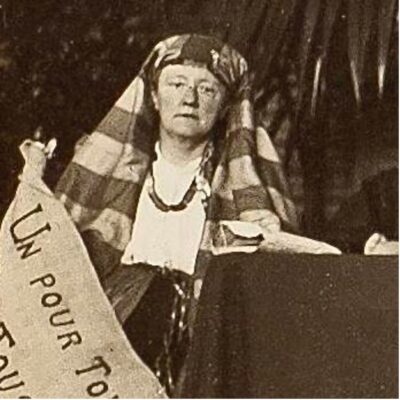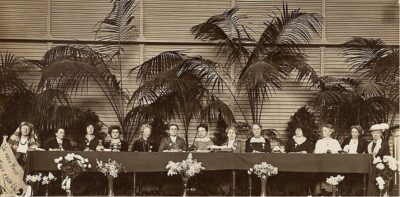Lucy Thoumaian (née Rossier de Visme)
“Your Sister of Every Land”

© LSE Library
The Ever-Helpful Daughter and Wife of a Minister
The story of our Swiss “Sister of Every Land” begins in Amiens (Somme, France) in the mid-19th century. Lucy Thoumaian, née Rossier de Visme, was the daughter of Anna de Visme, a Belgian-born writer (“femme de lettres”), and Louis Rossier, who worked in Amiens between 1846 and 1861. There is a certain ambiguity about Lucy’s exact birth date, but sources citing either 28 October in the year of 1856 or 1858 seem to be consistent in terms of the rather few things known about the upbringing of Lucy and her siblings in the peace of the Swiss mountain landscape.[1]
Lucy was, in her own words, not only the daughter of a minister, but also the wife of one.[2] Her sister Aline Hoffmann-Rossier, who like their mother worked as a writer, married a minister, too. Lucy met the young Armenian student Garabed (Karapet) Thoumaian during his studies in Lausanne (Switzerland).[3] After Garabed had completed his degree, he returned to his hometown Marsovan (Asia Minor) in the Ottoman Empire to work as a professor at the American Theological (Anatolia) College and as a preacher.[4] Lucy and Garabed married and settled in Marsovan over the next two to three years.[5] Lucy supported her esteemed husband’s charitable work among the Armenian community, as she had learned from an early age onward when aiding her father in Switzerland.[6] Yet, the living conditions of the poor in Armenia whom Lucy and Garabed tried to help differed greatly from those she had assisted in her Swiss homeland.[7] In the region of Marsovan, inhabited by about half a million people, there was no hospital and hardly a licensed doctor.[8] As a minority, the afflicted Armenian community increasingly suffered from discrimination and persecution in the Ottoman Empire.[9] In the aftermath of the Ottoman Empire’s defeat against Russia in the 1877-1878 war, improvement of conditions and reform calls were negotiated with interference from the European powers (referred to as the ‘Armenian question’).[10] Still, the suffering would not stop, and eventually, the situation would deteriorate – also for Lucy and Garabed.
The Voice of the Armenian People
With the aim of raising funds for a mission hospital, Lucy went to Europe, together with her first-born daughter, (La) France, named after the country of her family’s erstwhile home.[11] Her route to the United Kingdom led via Switzerland, where Lucy gave birth to her second daughter, Armenia, christened in tribute to her husband and her ‘adopted country’.[12] Armenia would die far too young at the age of only one, another daughter called Arméniette would be born around 1894.
Upon her arrival in the UK, Lucy was uncertain whether her mission would be of any success.[13] Still, she approached charitable religious communities, and little by little, friends supportive of the cause assembled.[14] Within two years, Lucy Thoumaian succeeded in raising 3.000 of the 6.000 Pounds required to build the mission hospital.[15]
At the Universal Peace Congress in Berne (Switzerland) in 1892, Lucy delivered a speech entitled “Our Country is the World”, in which she spoke on behalf of the Armenian community. An excerpt of this speech provides insights into her mission and virtues:
I am the voice of a people little known, forgotten, the voice of the Christian Armenians, alone, isolated in Asia, and they have sent me to tell you that they are your brethren [brothers]. As for their grievances – grievances well known – they are able, they, at least, ought to be able, Armenians though they are, to settle them by arbitration, by compromise.
Our duty is not to destroy but to build up, to build up for Peace monuments worthy of it, monuments of goodwill toward mankind.
Thus the missionary hospital for the poor sick Armenians, a hospital open to all, for which I am working, is itself the result of the principle of peace and of love: it ought to be so! We ought to succeed in exemplifying the principle.[16]
The Female ‘Knight Errant’ of the Story
In January 1893,[17] while in the middle of a meeting in the UK, Lucy learned about the imprisonment and torture of her husband.[18] Garabed, along with a colleague from Anatolia College and many other Armenians, was arrested by the authorities for allegedly issuing posters denouncing the regime.[19] He was detained with bail refused and visits denied.[20] Lucy acted right away. She approached members of Parliament in the lobby of the House of Commons, in embassies and the UK Foreign Office.[21] Still, Garabed, his colleague, and 16 more people, were tried and sentenced to death. The verdict was confirmed on appeal.[22] Lucy continued to fight relentlessly for her husband’s release. With the help of friends and the Foreign Secretary, Lord Rosebery, she finally obtained the release of Garabed and his colleague provided that they would leave the Empire.[23]
The issue of the Woman’s Herald from 10 August 1893 dedicated a biographical sketch to Lucy with the title “A Heroine from Armenia”.
The story of their rescue, their arrival in England after banishment from Turkey, is not without a touch of romance. Mediaeval romance it certainly is not, for the knight errant in this case is a woman who, true to the spirit which seems to actuate so many of the best women at the close of the nineteenth century, has braved all difficulties, disregarded time-serving conventionalities, and, making her way to the centre of authority, has succeeded not only in effecting the rescue of him she loves best, but of rousing public opinion on the question at large.[24]
In the following years,[25] the couple settled down in Chigwell (UK), where they continued to advocate for the Armenian community. In June 1895, the Woman’s Signal published a letter written by Lucy in which she expressed her dismay at the fact that some people in the UK refused to acknowledge the reports about the situation in Armenia.[26] But at least one person listened to them: The story of Lucy and Garabed is said to be the inspiration of the 1896 novel The Autobiography of a Truth by Ada Ellen Bayly, a Victorian writer and member of the Women’s Liberal Association, published under her pen name Edna Lyall. Other than, e.g., her books We Two or Donovan, The Autobiography of a Truth might not be considered one of Bayly’s major works, but it has been described as a “provocative novella”. The novel is written from the first-person perspective of the “Spirit of Truth” that tells the story of a young American girl named Faith and her fiancé, a young Armenian professor, named Kaspar. In the course of events, Kaspar is taken prisoner in his hometown for (alleged) seditious conspiracy and condemned to death. In the end, he is pardoned but must leave the country indefinitely. With this novel, Ada Ellen Bayly seemingly intended to draw attention to the situation of the Armenian community in the Ottoman Empire. She even added a list of authorities in the author’s note to support the accuracy of the story, and dedicated the profits of the novel to the Duke of Westminster for the Armenian Relief Fund.[27]
The “Every Woman” Movement and Women at The Hague
Returning to Lucy and Garabed’s real-life story: The couple opened a shelter for Armenian children in their UK home in 1906. In 1911, they took part in the first Universal Races Congress in London where they – even though exiled – formally embraced a delegate for the Ottoman Empire. Even more, Garabed proactively shook hands to emphasize the need for solidarity and cooperation.[28]
The following year, Lucy initiated the “Every Woman” International Movement, underscoring the responsibility of women to achieve peace. In 1914, she published “A Manifesto to Women of Every Land” shortly after the outbreak of World War I.[29] In the manifesto, she addressed her “[d]ear Sisters of Every Land” and wrote:
Whilst our respective soldiers go bravely to the front, and whilst we at home do what we can for the wounded and the distressed, there is something else still more important to do, of which no one seems to think and which is very specially suited also to the soothing and loving influence of woman. It is the preventing our beloved soldiers to become wounded! It is to work, and this internationally, in the interest of the future peace of Europe. It is whilst the human mind is proving the evils of war that it is best disposed to consider the advisability of peace for the present time and for all time.[30]
She suggested that “women everywhere” should hold “weekly women’s meetings” to “consider matters week by week, call out together, ‘each to our God’ and each to our Governments” until peace was secured.[31] According to the Manifesto, “resort to arbitration” was “the only possible means” to achieve peace and prevent further wars.[32] The Manifesto concludes resolutely:
We women cannot afford to allow this madness of war to go on, neither now nor at any future time; we have had enough of it![33]
In that spirit, Lucy Thoumaian attended the International Congress of Women in The Hague in April 1915. In this very month, the Armenian community in the Ottoman Empire saw massacres unfold once again, escalating to new dimensions. At the Congress, Lucy, representing Armenia, wore a traditional Armenian robe. She subsequently urged to trace deported Armenians, including relatives of hers from Marsovan.

© LSE Library
Women – individuals or members of organizations – met at The Hague with the aim of stopping the war and discussing means for the peaceful and long-lasting settlement of international disputes.[34] From the Congress emerged the International Committee of Women for Permanent Peace, later called Women’s International League for Peace and Freedom (WILPF), with Lucy as an initial member[35].
In the time that followed, she gave lecture’s on “women’s responsibility for influence toward peace” inter alia in New York, Washington and Baltimore (US).[36] Eventually, she settled in the US while her husband and children stayed in Chigwell. Unfortunately, not much is known about her post-war activities. With the support and pressure of the WILPF, Lucy was appointed for the Permanent Mandates Commission of the League of Nations. She continued her struggle for justice and peace until her death in 1940.
Further Readings
Lucy Thoumaian, ‘A Manifesto to Women of Every Land’ (1914) 8 Jus Suffragii 170, also reprinted in Maureen Moynagh and Nancy Forestell (eds), Documenting First Wave Feminisms (vol 1, University of Toronto Press 2011) 367-368.
N.N., ‘A Heroine from Armenia: The Life Story of Madame Thoumaian’ (1893) 8 The Woman’s Herald 388.
N.N., ‘1. Lucy Thoumaian’ (WILPF, June 2015).
N.N., ‘The War from a Woman’s Perspective: On the “Women for Peace” Campaign’ (Socioscope, 23 November 2022).
‘Records Relating to the Thoumaian Family’ (Essex Record Office, n.d.) ref D/DU 1777.
[1] A small insight into Lucy’s life up to 1893 provides the following biographical sketch from the same year, N.N., ‘A Heroine from Armenia: The Life Story of Madame Thoumaian’ (1893) 8 The Woman’s Herald 388.
[2] See Lucy Thoumaian, ‘Our Country Is the World’ (1892) 54 American Advocate of Peace 206.
[3] Antranig Azhderian, The Turk and the Land of Haig; Or Turkey and Armenia: Descriptive, Historical, and Picturesque (The Mershon Company Publishers 1898) 361 states that Garabed was a Luzern University alumnus.
[4] Cf. ‘A Heroine from Armenia’ (n 1) 388.
[5] ‘A Heroine from Armenia’ (n 1) 388.
[6] ‘A Heroine from Armenia’ (n 1) 388.
[7] ‘A Heroine from Armenia’ (n 1) 388.
[8] Cf. ‘A Heroine from Armenia’ (n 1) 388.
[9] See, e.g., Peter Balakian, ‘Armenians in the Ottoman Empire’ in David P. Forsythe (ed), Encyclopedia of Human Rights (vol 1, OUP 2009) 92 et seqq.
[10] See, e.g., Peter Balakian, ‘Armenians in the Ottoman Empire’ (n 9) 92-93.
[11] ‘A Heroine from Armenia’ (n 1) 388.
[12] ‘A Heroine from Armenia’ (n 1) 388.
[13] ‘A Heroine from Armenia’ (n 1) 388.
[14] ‘A Heroine from Armenia’ (n 1) 388.
[15] ‘A Heroine from Armenia’ (n 1) 388.
[16] Lucy Thoumaian, ‘Our Country Is the World’ (n 2) 206.
[17] Antranig Azhderian (n 3) 360 states that this occurred in January 1894.
[18] ‘A Heroine from Armenia’ (n 1) 388.
[19] Antranig Azhderian (n 3) 360.
[20] Antranig Azhderian (n 3) 360.
[21] ‘A Heroine from Armenia’ (n 1) 388.
[22] Antranig Azhderian (n 3) 361.
[23] Cf. ‘A Heroine from Armenia’ (n 1) 388 and Antranig Azhderian (n 3) 361.
[24] ‘A Heroine from Armenia’ (n 1) 388.
[25] In line with another source reading that Lucy and Garabed emigrated to the UK during the Armenian massacres, the short portray to this blog post also states that the couple moved there following the massacres. While the Armenian massacres are dated ca. 1894 to 1896/1897 and Garabed’s arrest, trial and exile to England occurred either in 1893 or 1894, it may be assumed that they moved to the UK in the precursor to the massacres. Sources and corresponding data seem not entirely consistent.
[26] See Lucy Thoumaian, ‘Correspondence: The Armenian Question’ (1895) 3 Woman’s Signal 365.
[27] Edna Lyall, The Autobiography of a Truth (2nd edn, Longmans, Green and Co) 113-114.
[28] ‘Record of the Proceedings of the First Universal Races Congress, held at the University of London’ (July 26-29, 1911) 70 <https://hdl.handle.net/2027/uiug.30112069959390> accessed 13 January 2025; see also Elise K. Burton, Genetic Crossroads: The Middle East and the Science of Human Heredity (SUP 2021) 31.
[29] Lucy Thoumaian, ‘A Manifesto to Women of Every Land’ (1914) 8 Jus Suffragii 170.
[30] Lucy Thoumaian, ‘A Manifesto to Women of Every Land’ (n 29) 170.
[31] Lucy Thoumaian, ‘A Manifesto to Women of Every Land’ (n 29) 170 [with omissions].
[32] Lucy Thoumaian, ‘A Manifesto to Women of Every Land’ (n 29) 170 [with omissions].
[33] Lucy Thoumaian, ‘A Manifesto to Women of Every Land’ (n 29) 170.
[34] See further ‘Report of the International Congress of Women, The Hague – The Netherlands, April 28th to May 1st, 1915’ (ca. 1915).
[35] Lucy’s name does not appear in the list of member of the International Committee of Women for Permanent Peace, however, which is included in a later report on the congress.
[36] N.N., ‘Brief Peace Notes’ (1916) 78 The Advocate of Peace 83.



